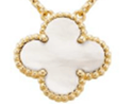PARASITISM – The 4-leaf clover no longer brings Van Cleef luck!
Legal watch
7 December 2023
Paris Court of Appeal, June 23, 2023, No. RG 21/19404: Louis Vuitton’s marketing of the BLOSSOM jewelry line, featuring Van Cleef & Arpels’ emblematic four-lobed clover motif, does not constitute parasitic competition.
In 2015, Van Cleef sued took legal actions against Louis Vuitton for parasitism on the grounds that its BLOSSOM jewelry line, marketed :
- (i) takes the four-leaf clover motif from its ALHAMBRA collection;
- (ii) is the meticulous capture of his own ALHAMBRA collection, which includes a coherent set of 31 four-lobed jewels;
- (iii) uses the same communication axes; and
- (iv) has adopted the same pricing policy.

Van Cleef & Arpels

Louis Vuitton Malletier
The Paris Commercial Court first recognized Louis Vuitton’s parasitic acts and ordered it to pay 214,400 euros in damages, prohibiting it from continuing to market its jewelry.
Following an appeal by Louis Vuitton, the Court overturned this ruling, considering that while the clover “is an emblematic and well-known product of the Van Cleef & Arpels brand; and therefore [has] an individualized economic value like the collection in which it is used“, Louis Vuitton had not positioned itself in the wake of Van Cleef.
More specifically, the Court of Appeal sought to respond to the various arguments put forward by Van Cleef.
- (i) With regard to the ALHAMBRA motif, the Court first noted that, despite the fact that this design is a repetition of a four-leaf clover and is identical in size to the plaintiff’s, there are numerous structural differences in the composition of the two jewelry collections.
In particular, the four-lobed shape of the BLOSSOM range is not routed, nor does it feature pearl settings or a double-sided character. The semi-precious stone is not smooth and has an additional element in its center.
The Court also considered that the four-lobed shape is “a well-known and customary element in the field of applied arts, particularly jewelry” and that “the use of colored precious or semi-precious stones set in precious metal appears to be part of fashion trends.
The Court added that Louis Vuitton found inspiration in its own four-leaf clover motif, found on its monogrammed canvas made up of the letters LV and four-petal flowers, and adapted it to market trends.
- (ii) The Court also rejected Van Cleef’s argument that Louis Vuitton had taken over the entire ALHAMBRA range, in addition to the motif itself, by creating a complete collection of 31 four-leaf jewels.
On the one hand, the Court noted that it is customary in the jewelry sector to offer a whole range of jewels (bracelets, earrings, necklaces, etc.).
On the other hand, Louis Vuitton’s BLOSSOM range also includes other floral motifs, in particular its emblematic pointed flower motif, which shows that it is not seeking to create a collection or sub-collection that would imitate, without any effort on its part, Van Cleef’s ALHAMBRA range.
What’s more, the colors of the semi-precious stones and the gold of the precious metal differ between the two ranges and are, once again, hues frequently used for the same collection in the jewelry sector.
- (iii) The judges then ruled that Van Cleef could not rely on an undue use of the theme of nature to communicate on the BLOSSOM collection, since it was processed differently in terms of colors, the same chromatic being used by Louis Vuitton to communicate on its other products, such as shoes.
The Court concluded that “no break in the communication strategy of the Vuitton companies with the aim of following in their wake” had been demonstrated.
- (iv) Lastly, the Court also concluded that the alleged adoption of a pricing policy had not been demonstrated for the BLOSSOM collection, since “price variances appear to be heterogeneous, and can be significantly lower, identical or higher depending on the product“.
The Court therefore ruled out any wrongful conduct on the part of Louis Vuitton on the basis of the evidence produced, “even taken in combination“, stressing that the risk of association “deduced from comments made by a few Internet users on social networks” was insufficient.

